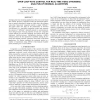Free Online Productivity Tools
i2Speak
i2Symbol
i2OCR
iTex2Img
iWeb2Print
iWeb2Shot
i2Type
iPdf2Split
iPdf2Merge
i2Bopomofo
i2Arabic
i2Style
i2Image
i2PDF
iLatex2Rtf
Sci2ools
ICIP
2002
IEEE
2002
IEEE
Open-loop rate control for real-time video streaming: analysis of binomial algorithms
Emerging real-time streaming applications often rely on rate-based flow control. However, congestion control for rate-based applications is typically dismissed as being not viable due to the common notion that "open-loop" congestion control is simply "difficult." This paper sheds new light on the performance of binomial NACK-based (i.e., rate-based) congestion control and measures the amount of "difficulty" inherently present in such protocols. Even though recent work [2] proposed several new congestion control methods for real-time streaming, our analysis shows that traditional Additive-Increase, Multiplicative-Decrease (AIMD) schemes possess the best packet-loss scalability among all proposed TCP-friendly schemes, especially when used in rate-based applications. We further confirmed our analytical results in a number of experiments using MPEG-4 Fine-Granular Scalable (FGS) streaming over a Cisco testbed.
Congestion Control | Congestion Control Methods | ICIP 2002 | Image Processing | Real-time Streaming Applications |
| Added | 24 Oct 2009 |
| Updated | 24 Oct 2009 |
| Type | Conference |
| Year | 2002 |
| Where | ICIP |
| Authors | Dmitri Loguinov, Hayder Radha |
Comments (0)

